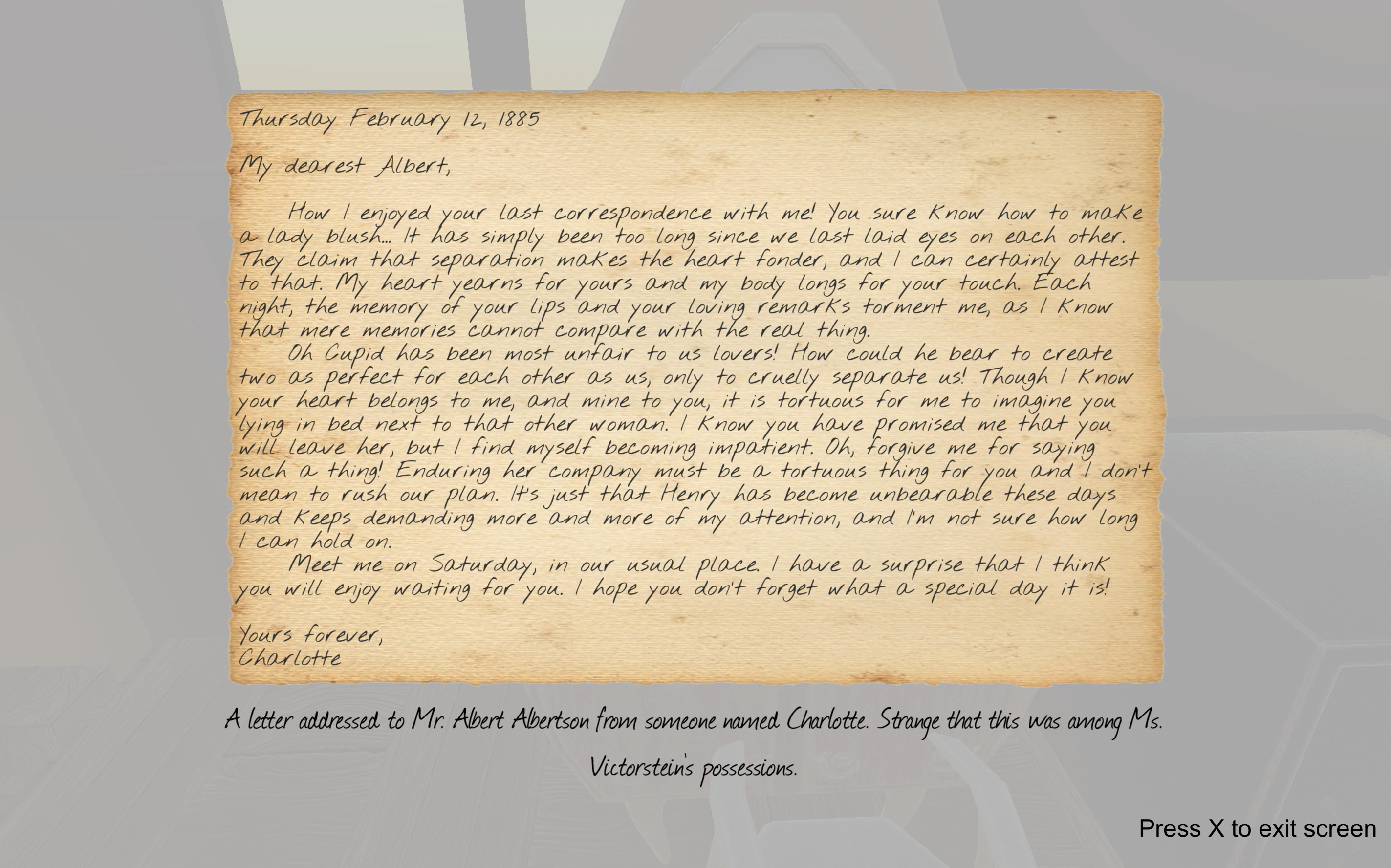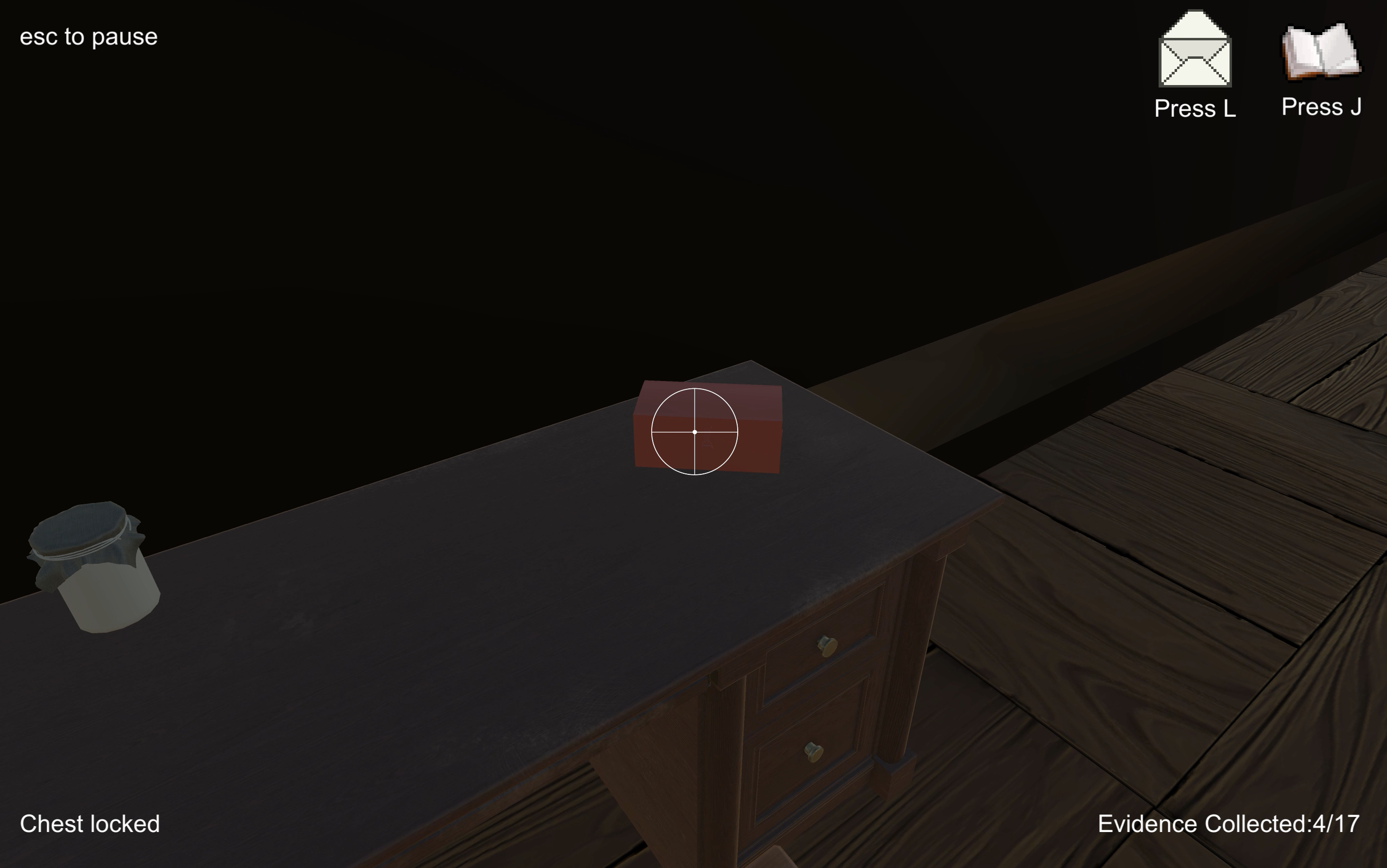MURDER? MURDER
3D Video Game






Worked for:
5 weeks, Apr - May 2022
Created by:
Lucy Anderson, Yosslay Cervantes, Isa Walters, and Erika Sampson
Individual Responsibilities:
5 weeks, Apr - May 2022
Created by:
Lucy Anderson, Yosslay Cervantes, Isa Walters, and Erika Sampson
Individual Responsibilities:
- game design
- narrative design
- programming
- 2D art assets
- animation
Murder? Murder is a 3D video game and was the final project for my game development course while studying abroad in Denmark. The game is set in the 1880s, and players assume the role of a private detective tasked with solving the murder of a prominent grocery store mogul by collecting evidence. At the end of the game, players must choose the suspect they believe committed the crime. Our goal for this project was to create a cohesive gaming experience with all the typical elements of a video game while working in a team of four, which was a larger team than I'm used to working with.
Development Process:
The initial phase of Murder? Murder's development was ideation. Our team decided on the core idea for the game, identified the assets and scripts we would need, and split up the responsibilities among ourselves.
Once we had the basic framework for the story, I focused on fleshing out the details of the mystery. This involved developing character motivations, backstories, alibis, and a precise timeline of events for the day of the murder. I also determined which pieces of evidence would be available to the player and where they should be placed. Next, I wrote all the letters that would serve as the main sources of evidence for solving the mystery. I also created 2D art assets for the evidence and implemented basic animations like the opening of drawers and doors.
Prior to starting development, I created a shared document to keep track of all the assets we needed and what tasks remained to be done. Throughout development, I delegated tasks and kept everyone on track. As I was familiar with what each member of the team was working on and their progress, in the final phase of development, my focus shifted to ensuring that their work could come together cohesively to form the game.
Challenges Faced:
As my teammates worked on their sections of the project in separate test scenes, it fell to me to integrate everything together in the actual game scene. Since they were working in isolation, there were unforeseen clashes that emerged once we tried to bring everything together. Often, these issues stemmed from conflicts in the scripts, which meant I had to dig into their code and fix any problems that arose, whether it involved the UI, camera movement, player mechanics, or other aspects of the game.
Lessons Learned:
The development of Murder? Murder pushed me out of my comfort zone and showed the importance of playtesting. As the person responsible for the narrative design, it was especially hard for me to judge the difficulty of the mystery. When our classmates were finally able to play our game, we found that our game was more difficult to figure out than we thought, and that most people didn’t want to engage with the large portions of text in our game unless they were players typically drawn to mystery games. If I were to come back to this project, I would try to reduce the game’s reliance on text, both to make the game more accessible and lessen the information overload on the player. I would also like to add some kind of voiceover option for the text, to contribute to accessibility.
Development Process:
The initial phase of Murder? Murder's development was ideation. Our team decided on the core idea for the game, identified the assets and scripts we would need, and split up the responsibilities among ourselves.
Once we had the basic framework for the story, I focused on fleshing out the details of the mystery. This involved developing character motivations, backstories, alibis, and a precise timeline of events for the day of the murder. I also determined which pieces of evidence would be available to the player and where they should be placed. Next, I wrote all the letters that would serve as the main sources of evidence for solving the mystery. I also created 2D art assets for the evidence and implemented basic animations like the opening of drawers and doors.
Prior to starting development, I created a shared document to keep track of all the assets we needed and what tasks remained to be done. Throughout development, I delegated tasks and kept everyone on track. As I was familiar with what each member of the team was working on and their progress, in the final phase of development, my focus shifted to ensuring that their work could come together cohesively to form the game.
Challenges Faced:
As my teammates worked on their sections of the project in separate test scenes, it fell to me to integrate everything together in the actual game scene. Since they were working in isolation, there were unforeseen clashes that emerged once we tried to bring everything together. Often, these issues stemmed from conflicts in the scripts, which meant I had to dig into their code and fix any problems that arose, whether it involved the UI, camera movement, player mechanics, or other aspects of the game.
Lessons Learned:
The development of Murder? Murder pushed me out of my comfort zone and showed the importance of playtesting. As the person responsible for the narrative design, it was especially hard for me to judge the difficulty of the mystery. When our classmates were finally able to play our game, we found that our game was more difficult to figure out than we thought, and that most people didn’t want to engage with the large portions of text in our game unless they were players typically drawn to mystery games. If I were to come back to this project, I would try to reduce the game’s reliance on text, both to make the game more accessible and lessen the information overload on the player. I would also like to add some kind of voiceover option for the text, to contribute to accessibility.
